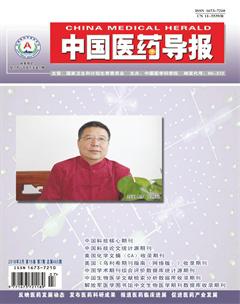mTOR信号通路在心肌肥大中的作用
陈兴 成传访 方燕龄 宫雅南 徐米清
[摘要] 目的 检测雷帕霉素靶蛋白(mTOR)信号通路蛋白在压力超负荷性心肌肥厚及H9c2心肌细胞肥大时的表达,探讨mTOR信号通路对心肌肥大的影响。 方法 将16只雄性SD大鼠随机分为腹主动脉缩窄术(AAC)组和假手术组,每组各8只。AAC后2周,实施超声心动图检查及病理学检查。体外研究采用去甲肾上腺素(NE)诱导H9c2心肌细胞肥大。Western blot检测mTOR信号通路相关蛋白表达。 结果 与假手术组比较,AAC组大鼠左室舒张末期后壁厚度(LVPWd)、室间隔舒张末期厚度(IVSd)和心脏重量指数(HWI)明显升高,差异均有统计学意义(P < 0.05)。Western blot检测发现,AAC组P-mTOR/mTOR蛋白表达比值明显高于假手术组,差异有统计学意义(P < 0.05)。体外研究中,NE组P-mTOR/mTOR蛋白表达比值明显升高,与对照组比较,差异有统计学意义(P < 0.05)。 结论 压力超负荷性心肌肥厚及H9c2细胞肥大时,mTOR信号通路相关蛋白表达增加,这提示mTOR信号通路在心肌肥大的发病过程中发挥重要作用。
[关键词] 雷帕霉素靶蛋白;信号通路;心肌肥大;腹主动脉缩窄术
[中图分类号] R541 [文献标识码] A [文章编号] 1673-7210(2018)03(a)-0016-04
[Abstract] Objective To detect protein the expression of mammalian target of rapamycin (mTOR) signaling in pressure-overloaded cardiac hypertrophy and H9c2 cardiomyocyte hypertrophy, and investigate effect of mTOR signaling on cardiac hypertrophy. Methods Sixteen SD rats were randomly grouped as the abdominal aorta coarctation (AAC) group and the sham group, with 8 rats for each group. Two weeks after AAC, echocardiography and histological analysis were performed. Norepinephrine (NE) was used to induce H9c2 cardiomyocyte hypertrophy in vitro. Relative protein expressions were detected for mTOR signaling by western blot. Results Compared with the sham group, rats in the ACC group showed a significant increase in left ventricular posterior wall end-diastolic thickness (LVPWd), interventricular septal end-diastolic thickness (IVSd) and heart weight index (HWI) (all P < 0.05). Western blot showed that there was a significant increased ratio of P-mTOR and mTOR protein expression in the AAC group compared with the sham group (P < 0.05). NE treatment significantly increased the ratio of P-mTOR and mTOR protein expression in vitro, with a significant difference compared with the control group (P < 0.05). Conclusion Protein expressions in mTOR signaling can be significantly increased in pressure-overloaded cardiac hypertrophy and H9c2 cardiomyocyte hypertrophy. mTOR signaling may play a key role in the pathogenesis of cardiac hypertrophy.
[Key words] Mammalian target of rapamycin; Signaling; Cardiac hypertrophy; Abdominal aorta coarctation
心肌肥大是心力衰竭發展中的重要病理过程,其具体发病机制不详,可能涉及多条信号通路,如钙调神经磷酸酶和钙/钙调依赖性蛋白激酶Ⅱ信号通路、丝裂原活化蛋白激酶信号通路、Janus激酶/转录激活因子信号通路等等[1-3]。雷帕霉素靶蛋白(mechanistic target of rapamycin,mTOR)是磷脂酰肌醇3-激酶相关激酶家族成员之一。研究显示,mTOR蛋白被认为可能是细胞内物质代谢诸多信号通路的交汇点,可能通过整合其上游生长、增殖和生存相关信号通路参与细胞代谢过程[4]。不过,mTOR信号通路是否及如何在心肌肥大过程中发挥作用仍不清楚。本研究采用腹主动脉缩窄术(abdominal aorta coarctation,AAC)建立压力超负荷性心肌肥厚大鼠模型,同时采用去甲肾上腺素(norepinephrine,NE)诱导H9c2心肌细胞肥大,检测mTOR信号通路相关蛋白表达,探讨心肌肥大与mTOR信号通路之间的关系。
1 材料与方法
1.1 实验对象和主要试剂
SD大鼠(南方医科大学实验动物中心,合格证号:44002100011714);H9c2心肌细胞(美国标准生物品收藏中心);NE(中国远大医药公司);P-mTOR抗体、mTOR抗体和GAPDH抗体(美国Cell Signaling Technology公司)。本研究动物实验获广州医科大学附属第二医院伦理委员会批准实施。
1.2 动物分组及处理
将16只10~12周龄雄性SD大鼠随机分为两组,每组8只。AAC组采用AAC建立压力超负荷性心肌肥厚大鼠模型,具体术式参考文献[5]并略有改进。假手术组采用相同术式,但不结扎腹主动脉。术后2周行超声心动图检查,并以此判断心肌肥厚大鼠模型是否建立成功。此后处死大鼠,留取心脏组织以备后续分子生物学研究需要。
1.3 超声心动图检查
经10%水合氯醛腹腔注射麻醉后,大鼠取左侧卧位,采用连接30 MHz高频探头的超声诊断仪(飞利浦IE33)经胸前壁进行二维超声检查。记录的超声心动图指标主要包括左室收缩末期内径(LVESD)、左室舒张末期内径(LVEDD)、左室舒张末期后壁厚度(LVPWd)、室间隔舒张末期厚度(IVSd)、左室射血分数(LVEF)和左室短轴缩短率(LVFS)。
1.4 心脏病理学检查
断颈法处死大鼠后,立即取出心脏,称取心脏重量,计算心脏重量指数(HWI),HWI=心脏重量/体重×100%。心脏组织经福尔马林固定液固定后制备石蜡切片,进行HE染色,显微镜下观察各组大鼠心肌组织的特征。
1.5 细胞培养及处理
H9c2心肌细胞采用含有10%胎牛血清(FBS)的DMEM培养基进行培养,无血清饥饿过夜后予药物处理。按处理因素将其分为两组,NE组给予2 μm NE处理细胞;对照组加入等量超纯灭菌水。药物处理2 h后,收集各组细胞。
1.6 Western blot检测
心脏组织和H9c2心肌细胞经细胞裂解、SDS-PAGE蛋白电泳、转膜、免疫反应(一抗包括P-mTOR、mTOR和GAPDH)、显示蛋白印迹等过程。采用Image StudioTM Lite software version 4.0软件定量分析各组蛋白质免疫印迹。
1.7 统计学方法
采用SPSS 17.0软件进行数据分析。计量资料以均数±标准差(x±s)表示,组间比较采用t检验,以P < 0.05为差异有统计学意义。
2 结果
2.1 一般情况
各组大鼠在处死前均存活,解剖时腹腔未见明显感染。
2.2 两组大鼠超声心动图检查指标的比较
与假手术组比较,AAC组大鼠LVPWd和IVSd明显升高,差异有统計学意义(P < 0.05)。两组大鼠LVESD、LVEDD、LVEF和LVFS比较差异无统计学意义(P > 0.05)。见表1。
2.3 心脏病理学检查
两组大鼠术后2周体重比较差异无统计学意义(P > 0.05)。AAC组心脏重量和HWI明显高于假手术组,差异有统计学意义(P < 0.05)。见表2。HE染色镜下观察显示,假手术组心肌细胞排列整齐,细胞浆丰富均匀,细胞间质正常;ACC组室间隔及左室室壁明显增厚,心肌细胞肥大,细胞间质增多。
2.4 mTOR信号通路相关蛋白表达
动物实验Western blot检测显示,与假手术组比较,AAC组P-mTOR/mTOR蛋白表达水平明显升高,差异有统计学意义[(1.00±0.18)比(1.76±0.39),P < 0.05]。见图1A。细胞实验Western blot检测显示,NE处理H9c2心肌细胞后诱导P-mTOR高表达,P-mTOR/mTOR水平明显高于对照组,差异有统计学意义[(1.00±0.03)比(1.79±0.34),P < 0.05]。见图1B。
3 讨论
心肌细胞肥大是心室肥厚的显著特征之一,是心室肥厚和重构的始动因素,从长远来看,更是心力衰竭、心源性猝死的病理基础[6]。本研究采用AAC这一经典术式构建大鼠心室肥厚模型,结果显示AAC组大鼠LVPWd和IVSd明显升高,心脏重量指数异常升高,证实AAC组大鼠出现心室肥厚;两组大鼠LVESD、LVEDD、LVEF和LVFS无统计学差异,提示AAC组大鼠尚未出现左心收缩功能障碍。组织病理学检查进一步证实AAC组大鼠心室肥厚,HE染色显示心肌细胞肥大,细胞间质增多,符合压力超负荷性心肌肥厚大鼠病理组织学改变。
mTOR,也称为FK506结合蛋白12雷帕霉素关联蛋白1,是在进化过程中相对保守的一类丝氨酸/苏氨酸蛋白激酶,主要通过形成mTOR复合体1和mTOR复合体2在细胞生存、生长代谢、细胞增殖、细胞极性、蛋白合成、自噬及应激等方面发挥重要作用[7-10]。mTOR信号通路已被证实在代谢性器官(如肝脏、骨骼肌、脂肪组织等)中发挥能量代谢和蛋白合成等功能[11-14]。近年来,研究者们更加关注mTOR信号通路在心血管系统正常生长发育和病理损伤中的作用,并取得了很大的进展。Zhu等[15]采用α-MHC驱动Cre重组酶敲除胚胎心脏心肌细胞中mTOR蛋白导致大量心肌细胞无法正常生长增殖,在孕末期导致高达92%胚胎死亡,这提示mTOR蛋白在鼠科动物心脏发育过程中是心肌细胞存活、增殖的关键因素。Ma等[16]在研究颈动静脉分流肺动脉高压大鼠模型时发现,雷帕霉素能够通过抑制Akt/mTOR信号通路减少细胞增殖,从而改善肺血管重塑。Gao等[17]研究发现,Akt/mTOR信号通路在异丙肾上腺素诱导的小鼠心肌肥厚中发挥重要作用。在本研究中,AAC组大鼠出现心肌肥厚表现,蛋白检测发现P-mTOR蛋白表达明显高于假手术组大鼠,这证实mTOR信号通路被压力超负荷性心肌机械刺激激活并参与心肌肥厚过程。在体外细胞研究中,国内外研究者发现mTOR信号通路可能在骨骼肌细胞肥大、血管紧张素Ⅱ诱导的心肌细胞肥大等过程中发挥关键作用[18-20]。本研究采用促肥厚剂NE促进H9c2心肌细胞肥大,结果表明NE处理2 h后可促进P-mTOR蛋白高表达,从而启动mTOR信号通路,这进一步证实mTOR信号通路参与了心肌细胞的肥大过程。
總之,本研究通过体内外研究证实mTOR信号通路在心肌细胞肥大和左室肥厚病理过程中发挥重要作用,这可能成为防治心室肥厚、延缓心力衰竭治疗的重要靶点。
[参考文献]
[1] Schirone L,Forte M,Palmerio S,et al. A review of the molecular mechanisms underlying the development and progression of cardiac remodeling [J]. Oxid Med Cell Longev,2017. doi:10.1155/2017/3920195. [Epub ahead of print]
[2] Wagner MA,Siddiqui MA. The JAK-STAT pathway in hypertrophic stress signaling and genomic stress response [J]. JAKSTAT,2012,1(2):131-141.
[3] Stylianidis V,Hermans KCM,Blankesteijn WM. Wnt signaling in cardiac remodeling and heart failure [J]. Handb Exp Pharmacol,2017,243:371-393.
[4] Kendall RT,Lee MH,Pleasant DL,et al. Arrestin-dependent angiotensin AT1 receptor signaling regulates Akt and mTor-mediated protein synthesis [J]. J Biol Chem,2014, 289(38):26155-26166.
[5] Chen B,Zhong LY,Yang JX,et al. Alteration of mevalonate pathway related enzyme expressions in pressure overload-induced cardiac hypertrophy and associated heart failure with preserved ejection fraction [J]. Cell Physiol Biochem,2013,32(6):1761-1775.
[6] Shenasa M,Shenasa H. Hypertension,left ventricular hypertrophy,and sudden cardiac death [J]. Int J Cardiol,2017, 237:60-63.
[7] Sciarretta S,Volpe M,Sadoshima J. Mammalian target of rapamycin signaling in cardiac physiology and disease [J]. Circ Res,2017,114(3):549-564.
[8] Magrys A,Bogut A,Kielbus M,et al. The role of the PI3K/mTOR signaling pathway in Staphylococcus epidermidis small colony variants intracellular survival [J]. Immunol Invest,2018,16:1-13.
[9] Johnson CE,Tee AR. Exploiting cancer vulnerabilities:mTOR,autophagy,and homeostatic imbalance. Essays Biochem,2017,61(6):699-710.
[10] Zhao Y,Hu X,Liu Y,et al. ROS signaling under metabolic stress:cross-talk between AMPK and AKT pathway [J]. Mol Cancer,2017,16(1):79.
[11] Panasyuk G,Patitucci C,Espeillac C,et al. The role of the mTOR pathway during liver regeneration and tumorigenesis [J]. Ann Endocrinol(Paris),2013,74(2):121-122.
[12] Martin NRW,Turner MC,Farrington R,et al. Leucine elicits myotube hypertrophy and enhances maximal contractile force in tissue engineered skeletal muscle in vitro [J]. J Cell Physiol,2017,232(10):2788-2797.
[13] Ma X,Han M,Li D,et al. L-arginine promotes protein synthesis and cell growth in brown adipocyte precursor cells via mTOR signal pathway [J]. Amino Acids,2017, 49(5):957-964.
[14] Paschoal VA,Amano MT,Belchior T,et al. mTORC1 inhibition with rapamycin exacerbates adipose tissue inflammation in obese mice and dissociates macrophage phenotype from function [J]. Immunobiology,2017,222(2):261-271.
[15] Zhu Y,Pires KM,Whitehead KJ,et al. Mechanistic target of rapamycin(Mtor)is essential for murine embryonic heart development and growth [J]. PLoS One,2013,8(1):e54221.
[16] Ma X,Yao J,Yue Y,et al. Akt/mTOR signalling pathway down-regulation in the carotid artery-jugular vein shunt pulmonary hypertension rat model [J]. Interact Cardiovasc Thorac Surg,2017. doi:10.1093/icvts/ivx053. [Epub ahead of print]
[17] Gao L,Guo Y,Liu X,et al. KLF15 protects against isoproterenol-induced cardiac hypertrophy via regulation of cell death and inhibition of Akt/mTOR signaling [J]. Biochem Biophys Res Commun,2017,487(1):22-27.
[18] Cai X,Zhu C,Xu Y,et al. Alpha-ketoglutarate promotes skeletal muscle hypertrophy and protein synthesis through Akt/mTOR signaling pathways [J]. Sci Rep,2016, 6:26802.
[19] Kitakaze T,Sakamoto T,Kitano T,et al. The collagen derived dipeptide hydroxyprolyl-glycine promotes C2C12 myoblast differentiation and myotube hypertrophy [J]. Biochem Biophys Res Commun,2016,487(3):1292-1297.
[20] Du M,Huang K,Gao L,et al. Nardosinone protects H9c2 cardiac cells from angiotensin Ⅱ-induced hyptertrophy [J]. J Huazhong Univ Sci Technolog Med Sci,2013,33(6):822-826.

